What’s in a Face? The Age and Complexion of Planetary Surfaces
Like members of a family, the four terrestrial planets all bear a certain resemblance to one another. They are all differentiated planets, with an iron-nickel core, silicate mantle, and outer crust. But, as we have just seen, there are no twins in this family. Their different sizes and masses, and their variable distances from the Sun, make all four planets, and especially their surfaces, distinct.
Like human faces, the faces of planets reveal their ages. Instead of forming wrinkles as they get older, the surfaces of terrestrial planets are marked by craters. The surfaces of Mercury, Mars, and the Moon are heavily cratered and therefore obviously old. In contrast, Venus and Earth have very few craters because their surfaces are much younger. In this section, we will study planetary surfaces to learn about the tectonic and climate processes that have shaped them. Earth is excluded here because it is the subject of this textbook, and Mars will be mentioned only briefly because its surface is more thoroughly described in the following section.
The Man in the Moon: A Planetary Time Scale
If you look at the face of the Moon through binoculars on a clear night, you will see two distinct types of terrain: rough areas that appear light-colored with lots of big craters, and smooth, dark areas, usually circular in shape, where craters are small or nearly absent (Figure 9.8). The light-colored regions are the mountainous lunar highlands, which cover about 80 percent of the surface. The dark regions are low-lying plains called lunar maria, from the Latin for “seas,” because they looked like seas to early Earth-bound observers. It is the contrast between highlands and maria that forms the pattern we can see from Earth as the “Man in the Moon.”
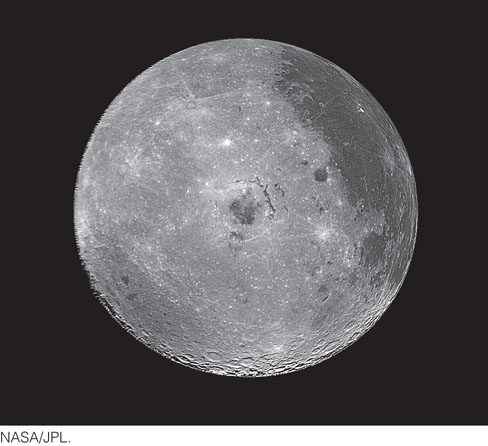
In preparation for the Apollo missions to the Moon, geologists such as Gene Shoemaker (Figure 9.9) developed a relative time scale for the formation of lunar surfaces based on the following simple principles:
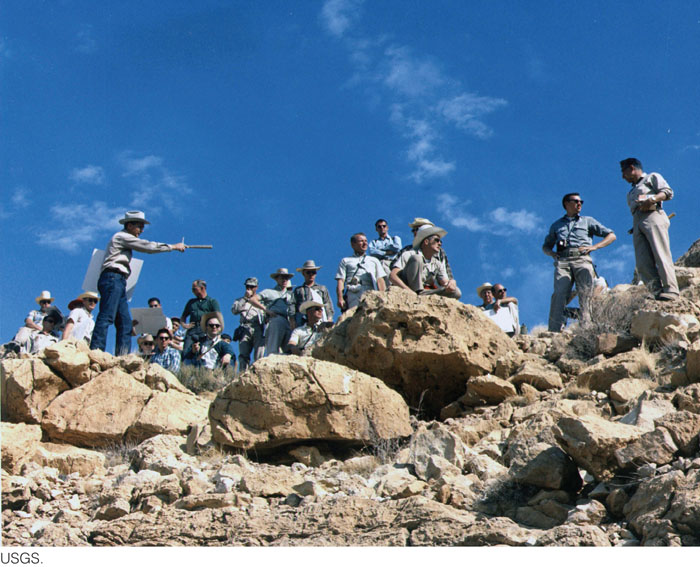
 Craters are absent on a new geologic surface; older surfaces have more craters than younger surfaces.
Craters are absent on a new geologic surface; older surfaces have more craters than younger surfaces. Impacts by small bodies are more frequent than impacts by large bodies; thus, older surfaces have larger craters.
Impacts by small bodies are more frequent than impacts by large bodies; thus, older surfaces have larger craters. More recent impact craters cross-cut or cover older craters.
More recent impact craters cross-cut or cover older craters.
By applying these principles, and by mapping the numbers and sizes of craters—a procedure known as crater counting—geologists showed that the lunar highlands are older than the maria. They interpreted the maria to be basins formed by the impacts of asteroids or comets that were subsequently flooded with basalts, which “repaved” the basins. They were able to assign different parts of the Moon’s surface to geologic intervals analogous to those in the relative time scale worked out by nineteenth-century geologists for Earth.
In the pre-Apollo days, no one knew the absolute ages of either the maria or the highlands, but the smart money held that both were very old. The intense cratering evident in the highlands and the big impacts that formed the maria were consistent with the results of theoretical models of the early solar system. These models predicted a period called the Heavy Bombardment, during which the planets collided frequently with the residual materials that still cluttered the solar system after they had been assembled (Figure 9.10). According to the models, the numbers and sizes of impacting objects would have been greatest just after the planets formed and would have quickly decreased as the materials were swept up by the planets.

By applying the isotopic dating methods described in Chapter 8 to rock samples brought back by the Apollo astronauts, geologists were able to calibrate the absolute time scale for the Moon that they had developed by crater counting. Sure enough, the highlands turned out to be very ancient (4.4 billion to 4.0 billion years old) and the maria younger (4.0 billion to 3.2 billion years old). Figure 9.11 plots these ages on the ribbon of geologic time.
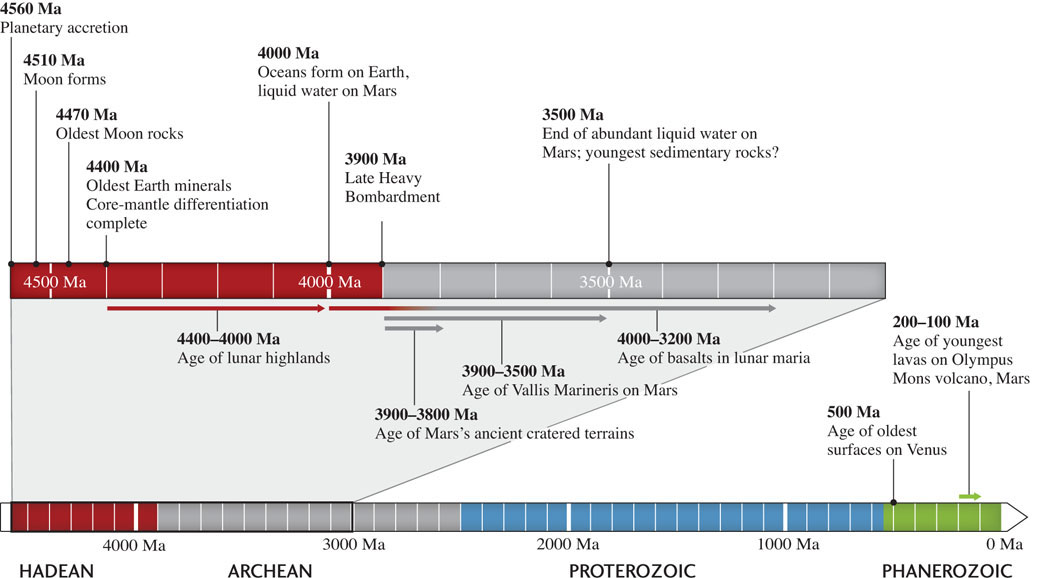
231
The relatively young ages of the maria turned out to be a puzzle, however. The best computer simulations of the Heavy Bombardment indicated that it should have been over rather quickly, perhaps in a few hundred million years or even less. Why, then, did some of the biggest impacts observed on the Moon—those that formed the maria—occur so late in lunar history?
The simulations missed an important event. The rate at which large objects struck the Moon did decrease quickly, as the simulations predicted, but then spiked up again in a period known as the Late Heavy Bombardment, which occurred between about 4.0 billion and 3.8 billion years ago (see Figure 9.10). The explanation of this event is still controversial, but it is likely that small changes in the orbits of Jupiter and Saturn about 4 billion years ago (caused by their gravitational interactions as they settled into their present orbits) perturbed the orbits of the asteroids. Some of the asteroids were thrown into the inner solar system, where they collided with the Moon and the terrestrial planets, including Earth. The Late Heavy Bombardment explains why so few rocks on Earth have ages greater than 3.9 billion years. It is the Late Heavy Bombardment that marks the end of the Hadean eon and the beginning of the Archean eon (see Figure 9.11).
The time scale first developed for the Moon by crater counting has been extended to other planets by taking into account the differences in impact rates resulting from each planet’s mass and position in the solar system.
Mercury: The Ancient Planet
The topography of Mercury is poorly understood. Mariner 10 was the first and only spacecraft to visit Mercury when it flew by the planet in March 1974. It mapped less than half the planet, and we have little idea of what is on the other side.
232
Mariner 10 confirmed that Mercury has a geologically dormant, heavily cratered surface. It has the oldest surface of all the terrestrial planets (Figure 9.12). Between its large old craters lie younger plains, which are probably volcanic, like the lunar maria. The Mariner 10 images show a difference in color between the craters and the plains, which supports this hypothesis. Unlike Earth and Venus, Mercury shows very few features that are clearly due to tectonic forces having reshaped its surface.
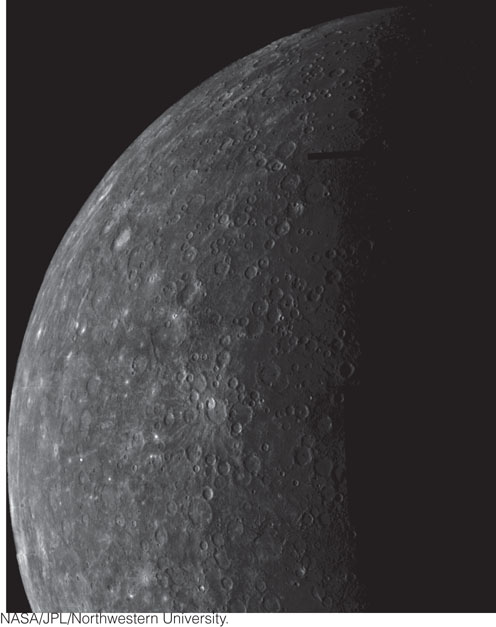
In many respects, the face of Mercury seems very similar to that of Earth’s Moon. The two bodies are similar in size and mass, and most of their tectonic activity took place within the first billion years of their histories. There is one interesting difference, however. Mercury’s face has several scars marked by scarps nearly 2 km high and up to 500 km long (Figure 9.13). Such features are common on Mercury, but rare on Mars and absent on the Moon. These cliffs appear to have resulted from horizontal compression of Mercury’s brittle crust, which formed enormous thrust faults (see Chapter 7). Some geologists think they formed during the cooling of the planet’s crust immediately after its formation.
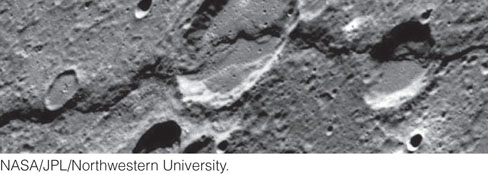
On August 3, 2004, the first new mission to Mercury in 30 years was launched successfully. The MESSENGER spacecraft successfully entered an orbit around Mercury in March 2011. MESSENGER has been providing information about Mercury’s surface composition, its geologic history, and its core and mantle, and it will search for evidence of water ice and other frozen gases, such as carbon dioxide, at the planet’s poles.
233
Venus: The Volcanic Planet
Venus is our closest planetary neighbor, often brightly visible in the sky just before sunset. Yet in the early decades of space exploration, Venus frustrated scientists. The entire planet is shrouded in a dense fog of carbon dioxide, water vapor, and sulfuric acid, which prevents scientists from studying its surface with ordinary telescopes and cameras. Although many spacecraft were sent to Venus, only a few were able to penetrate this acid fog, and the first ones that tried to land on its surface were crushed under the tremendous weight of its atmosphere.
It was not until August 10, 1990, after traveling 1.3 billion kilometers, that the Magellan spacecraft arrived at Venus and took the first high-resolution pictures of its surface (Figure 9.14). Magellan did this using radar (shorthand for radio detection and ranging) devices similar to the cameras that police officers use to enforce speed limits (they “see” at night, and through the fog, to clock your speed). Radar cameras form images by bouncing radio waves off stationary surfaces (like those of planets) or moving surfaces (like those of cars).
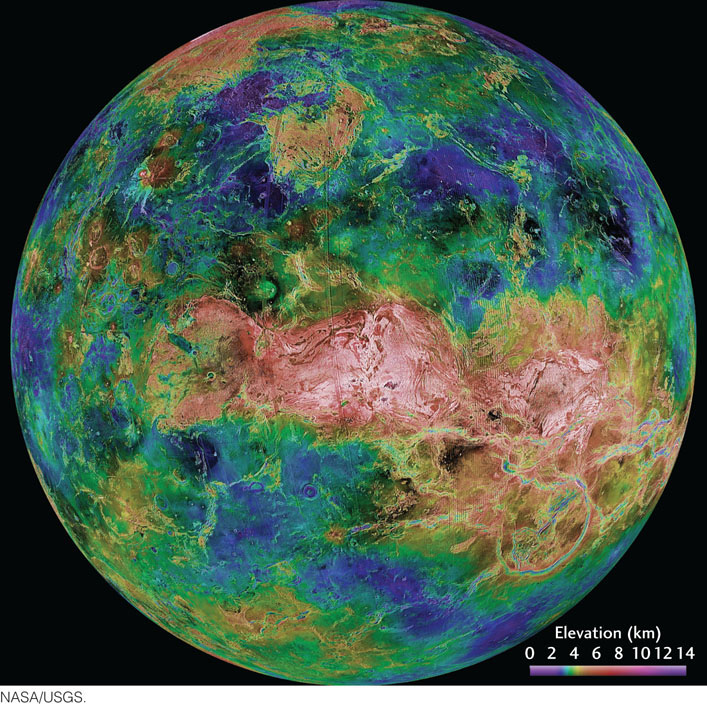
The images that Magellan returned to Earth show clearly that beneath its fog, Venus is a surprisingly diverse and tectonically active planet with mountains, plains, volcanoes, and rift valleys. The lowland plains of Venus—the blue regions in Figure 9.14—have far fewer craters than the Moon’s youngest maria, indicating that they must be younger still. Estimates of their age range between 1600 million and 300 million years. Because there is no rain on Venus, there is very little erosion, and so the features we see today have been “locked in” for all that time. The relatively low number of craters suggests that many craters must have been covered by lava, and therefore that Venus must have been tectonically active relatively recently.
234
The young plains are dotted with hundreds of thousands of small volcanic domes 2 to 3 km across and perhaps 100 m or so high, which formed over places where Venus’s crust got very hot. There are larger, isolated volcanoes as well, up to 3 km high and 500 km across, similar to the shield volcanoes of the Hawaiian Islands (Figure 9.15a). Magellan also observed unusual circular features called coronae that appear to result from blobs of hot lava that rose, created a large bulge or dome in the surface, and then sank, collapsing the dome and leaving a wide ring that looks like a fallen soufflé (Figure 9.15b).
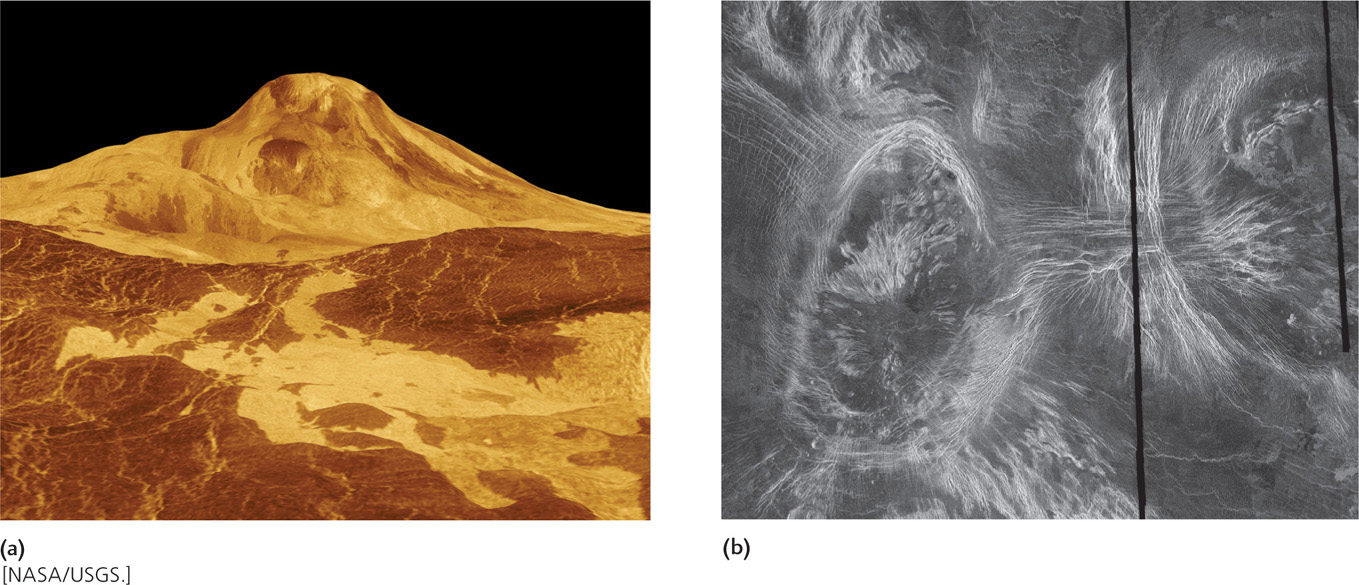
235
Because Venus has so much evidence of widespread volcanism, it has been called the Volcanic Planet. Venus has a convecting mantle like Earth’s, in which hot material rises and cooler material sinks (Figure 9.16a), but unlike Earth, it does not appear to have thick plates of rigid lithosphere. Instead, only a thin crust of frozen lava overlies the convecting mantle. As the vigorous convection currents push and stretch the surface, the crust breaks up into flakes or crumples like a rug, and blobs of hot magma bubble up to form large landmasses and volcanic deposits (Figure 9.16b). Scientists have called this process flake tectonics. When Earth was younger and hotter, it is possible that flakes, rather than plates, were the main expression of its tectonic activity.

Mars: The Red Planet
Of all the planets, Mars has a surface most similar to Earth’s. Mars has features suggesting that liquid water once flowed across its surface, and liquid water may still exist in its deep subsurface. And where there is water, there may be living organisms. No other planet in the solar system has as much chance of harboring extraterrestrial life as Mars.
The abundance of iron oxide minerals on the surface of Mars gives the Red Planet its name. Iron oxide minerals are common on Earth and tend to form where weathering of iron-bearing silicates occurs. We now know that many other minerals common on Earth, such as olivine and pyroxene, which form in basalt, are also present on Mars. But there are other relatively unusual minerals on Mars, such as sulfates, that record an earlier, wetter phase when liquid water may have been stable.
The topography of Mars shows a greater range of elevation than that of Earth or Venus (see Figure 9.7). Olympus Mons, at 25 km high, is a giant, recently active volcano—the tallest mountain in the solar system (Figure 9.17a). The Vallis Marineris canyon, 4000 km long and averaging 8 km deep, stretches the distance from New York to Los Angeles and is five times deeper than the Grand Canyon (Figure 9.17b). Recently, geologists have discovered evidence of past glacial processes, when ice sheets similar to the ones that covered North America during the most recent ice age flowed across the surface of Mars. Finally, like the Moon, Mercury, and Venus, Mars has both heavily cratered ancient highlands and younger lowlands. However, unlike those of Mercury, Venus, and the Moon, the lowlands of Mars are created not only by lava flows, but also by sediments, sedimentary rocks, and accumulations of windblown dust.
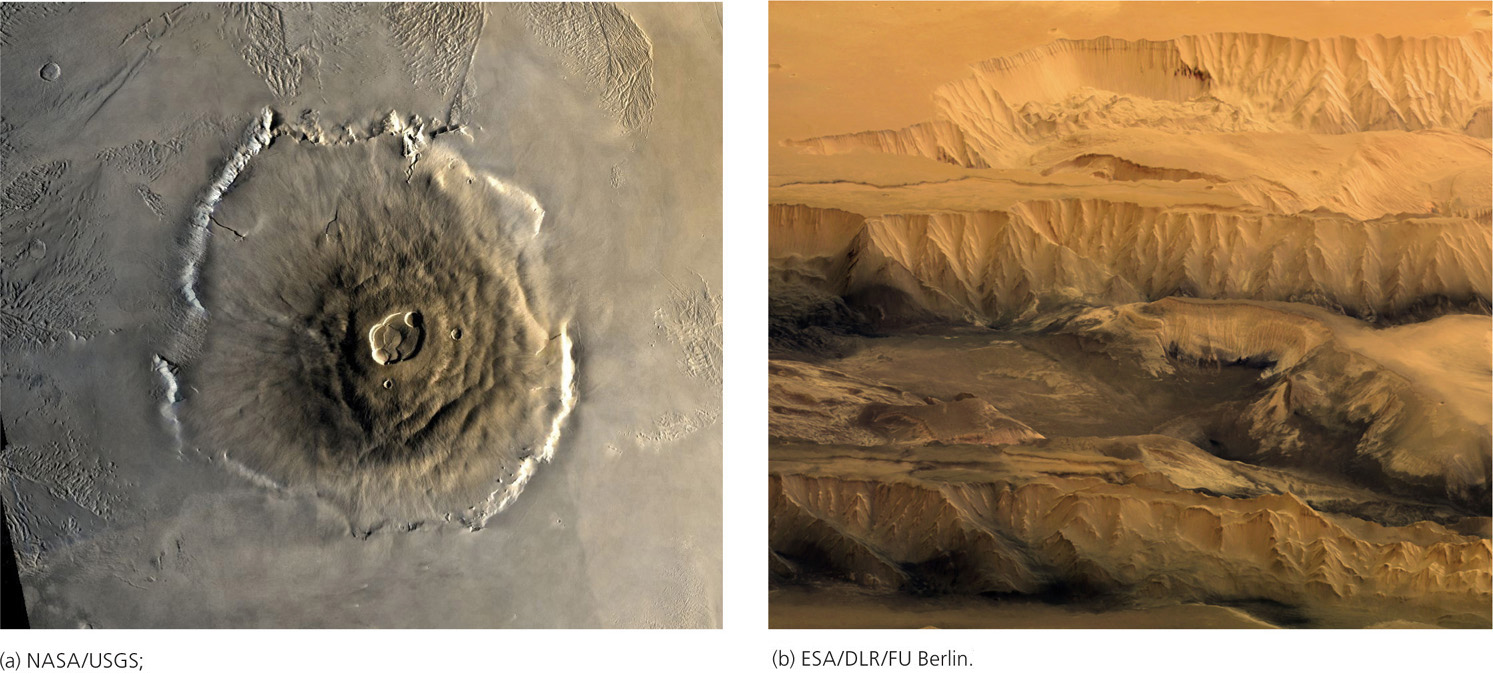
236
The face of Mars may be sophisticated, but it has not always been easy to read, despite being visited and viewed more than any other planet except Earth. But, as we will see shortly, Mars’s secrets are finally being revealed.
Earth: No Place Like Home
Every view of Earth underscores the unique beauty created by the overwhelming influences of plate tectonics, liquid water, and life. From its blue skies and oceans and its green vegetation to its rugged ice-covered mountains and moving continents, there truly is no place like home. Earth’s remarkable appearance is maintained by the delicate balance of conditions necessary to support and sustain life.
The features that define the face of our planet are discussed throughout this textbook, but one process that is appropriate to review here is cratering. The impacts of meteorites and asteroids are preserved in the geologic record of all the terrestrial planets, but in contrast to the other planets, whose surfaces are essentially frozen in time, Earth preserves very few vestiges of its beginning. Recycling by plate tectonics, which is even more efficient than flake tectonics on Venus, has almost completely resurfaced our planet. Those craters that do remain are much younger than the end of the Late Heavy Bombardment, and they are preserved entirely on continents, which resist subduction (Figure 9.18).
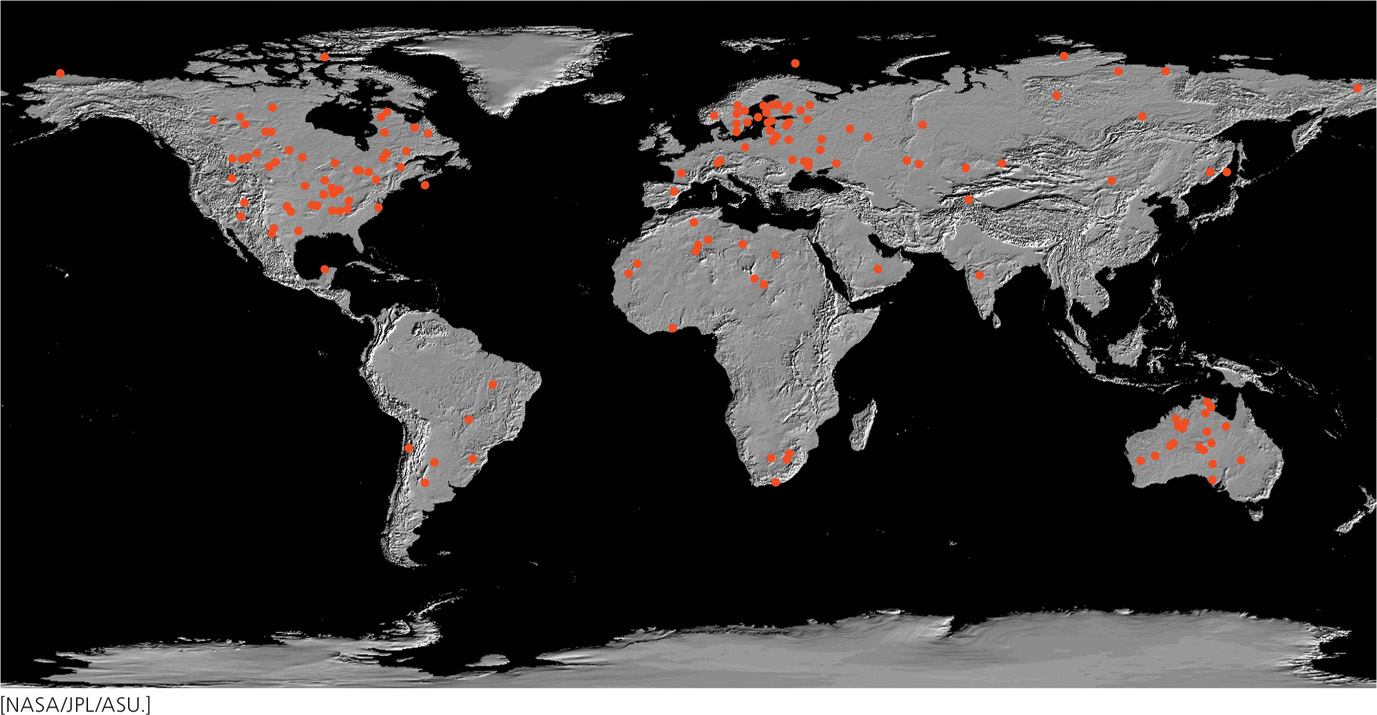
Nevertheless, Earth accumulates a lot of junk from space. At present, some 40,000 tons of extraterrestrial material fall on Earth each year, mostly as dust and unnoticed small objects. Although the rate of impacts is now orders of magnitude lower than it was during the Heavy Bombardment, a large chunk of matter 1 to 2 km in size still collides with Earth every few million years or so. Although such collisions have become rare, telescopes are being assigned to search space and warn us in advance of sizable bodies that might slam into Earth. NASA astronomers recently predicted “with non-negligible probability” (1 chance in 300) that an asteroid 1 km in diameter will collide with Earth in March 2880. Such an event would threaten human civilization.
We already know that impacts with large objects can greatly upset the conditions that support life on Earth. As we will see in Chapter 11, a collision with a 10-km asteroid 65 million years ago caused the extinction of 75 percent of Earth’s species, including all the dinosaurs. This event may have made it possible for mammals to become the dominant species and paved the way for humankind’s emergence. Table 9.2 describes the potential effects of impacts by objects of various sizes on our planet and its life-forms.
237
| Example or Size Equivalent | Most Recent | Planetary Effects | Effects on Life | |
|---|---|---|---|---|
| Supercolossal: radius (R) > 2000 km | Moon-forming event | 4.51 × 109 years ago | Melts planet | Drives off volatiles; wipes out life on Earth |
| Colossal: R > 700 km | Pluto | More than 4.3 × 109 years ago | Melts crust | Wipes out life on Earth |
| Huge: R > 200 km | 4 Vesta (large asteroid) | About 4.0 × 109 years ago | Vaporizes oceans | Life may survive below surface |
| Extra large: R > 70 km | Chiron (largest active comet) | 3.8 × 109 years ago | Vaporizes upper 100 m of oceans | May wipe out photosynthesis |
| Large: R > 30 km | Comet Hale-Bopp | About 2 × 109 years ago | Heats atmosphere and surface to about 1000 K | Burns continents |
| Medium: R > 10 km | Cretaceous- Tertiary impactor; 433 Eros (largest near-Earth asteroid) | 65 × 106 years ago | Causes fires, dust, darkness; chemical changes in ocean and atmosphere; large temperature swings | Cretaceous- Tertiary impact caused extinction of 75 percent of species and all dinosaurs |
| Small: R > 1 km | About size of near-Earth asteroids | About 300,000 years ago | Causes global dusty atmosphere for months | Interrupts photosynthesis; individuals die but few species extinct; threatens civilization |
| Very small: R > 100 m | Tunguska event (Siberia) | 1908 | Knocked over trees of kilometers away; caused minor hemispheric effects; dusty atmosphere | Newspaper headlines; romantic sunsets; increased birth rate |
| Source: J. D. Lissauer, Nature 402 (1998): C11–C14. | ||||